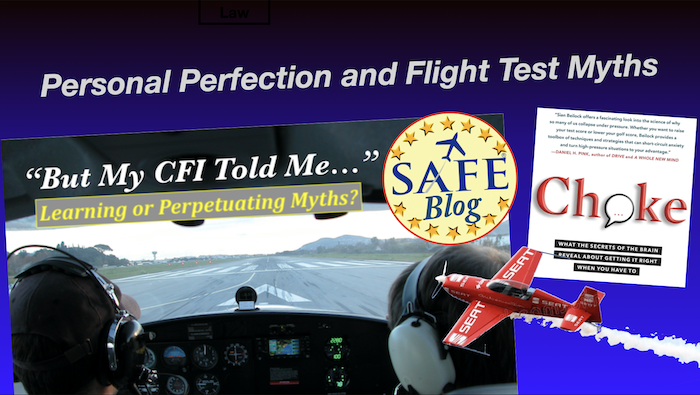
Perfection is an important goal in flight training and piloting. We should always aim for the highest standards,. But everyone needs to understand that perfection, by definition, is not achievable (especially on a flight test). Perfection is also not the standard for a successful flight test. All FAA evaluations enforce a pass/fail (70%) standard.“Perfection is not the standard.” It is important to emotionally prepare for some stuff to go (mildly) wrong. I have been a DPE for >25 years giving lots of tests, and have personally taken >50 flight evaluations myself; stuff happens!

Unfortunately, many flight test candidates ruin their performance on flight tests with self-defeating criticism of their own performance (guilty). As soon as a few minor errors occur, many applicants are crushed – psychologically and start to give up! It is critical for test success to remember,”stuff happens” in all flying. The goal in flight testing – and flying – is to always be correcting back to a high  standard. Subsequent reflection (after action) is an important pilot trait, but in the heat of battle, don’t let that “Perfect Polly” ruin your flying. Your DPE is required to inform you when a maneuver is unsuccessful. If you hear nothing, suck it up and keep flying. Remember, a maneuver may not meet *your* standard – it is test day, after all, and you’re nervous – but the FAA test is pass/fail.
standard. Subsequent reflection (after action) is an important pilot trait, but in the heat of battle, don’t let that “Perfect Polly” ruin your flying. Your DPE is required to inform you when a maneuver is unsuccessful. If you hear nothing, suck it up and keep flying. Remember, a maneuver may not meet *your* standard – it is test day, after all, and you’re nervous – but the FAA test is pass/fail.
Some Common Social Media Myths:

“Sorry you are the fifth flight test candidate and I need to keep my failure rate up!” is the mythical DPE secret you don’t want to hear as you pay for your flight test. Social media is full of all kinds of flight test rumors so I thought it might be valuable to discuss a few here. It *is* true that the private pilot test has an increasing failure rate now exceeding the initial CFI level. I think this is because PPL is a pilot’s first experience with FAA testing and they are often not adequately prepared – psychologically and also informationally – for that first FAA testing experience. To that end, let’s discuss some common “DPE mythology.”
DPEs *Do Not* have an FAA failure quota!
A DPE failure quota is often used as an excuse for why a checkride is unsuccessful by either the applicant or the recommending CFI. This myth rationalizes a candidate’s failure as caused by an unfair FAA policy (which is totally false). This myth is also spread by CFIs that fail to fully prepare their applicants. PPL is especially difficult for new applicants.
If you are unsuccessful on an evaluation, your Notice of Disapproval must clearly state the reason(s) and every DPE owes an explanation to the applicant for what was missing or wrong so a future attempt can be successful. All these comments travel with your IACRA file and are visible to another DPE on your next evaluation. And all the wrong answers on your knowledge test are required to be retested by the DPE – so be sure you practice the correct answers.

You can look it up, and make (a few) mistakes!

This is a practical test, so you can refer to your guidance (but not continuously and for everything – this is not a Google search competition). If it is something you might need in flight, your references are mostly limited to checklists and kneeboard items. TO that end, it is important to have a working knowledge of your reference materials so it is not an “Easter Egg Hunt” through the FAR/AIM.
Regarding mistakes, the FAA clearly states in many places that “perfection is not the standard!” When the 8710 is submitted, an applicant is theoretically at 100% (you are whatever your CFI says you are with their endorsement) and errors are marked down to the pass/fail 70% level. The FAA evaluation is the DPE “checking” your CFI’s preparation and recommendation. Though perfection is not the standard, it certainly is the goal. Remember, all the FAA test standards define the *minimum* acceptable performance. A conscientious CFI trains to a higher standard than the minimum for recommendation; e.g. +/- 50 ft, since you will be nervous and this will not be your “best flight ever!”
In the oral, an applicant must demonstrate a pattern of incorrect understanding to be issued a disapproval. In flight, the ACS states the applicant fails for “Consistently exceeding tolerances” or “Failure to take prompt corrective action;” keep flying and correcting back to the standard.

With that said, there are certain “one-off” (non-correctable) failures that will result in an immediate disapproval: the famous commercial 180 power-off accuracy landing is an example. Exceeding a published limitation or examiner intervention for safety is also an immediate unsat. In most cases though, like the oral, a DPE is looking for a pattern of sloppy flying, lack of knowledge, or poor risk management.
The DPE has to test within the FAA standards!
DPEs are legally limited to the items stated in the ACS (and the reference materials) by the FAA: this is not a “personal test.” It should not go out of the listed FAA Areas of Operation and Tasks. Evaluations with a “selection process” (Initial CFI) still require an applicant to be fully trained and proficient in *ALL* listed maneuvers (in case they are chosen by the DPE). Additionally, on any retest, the DPE is allowed to evaluate additional tasks (previously “passed”) if it seems like they are questionable (taxi to the wrong runway without a taxi diagram?).
The pilot evaluation process is admittedly subjective no matter how many standards and criteria the FAA creates (or it would be a CloudAhoy data track). Show up on time and be respectful, dress and act like a professional. The FAA works very hard to assure fair and honest evaluations, but there is always the human element on both sides. If your test was way off the mark – asking inappropriate questions or exhibiting inappropriate behavior – the FAA wants to know. Talk to your FSDO or use the FAA hotline. This assures anonymity and whistleblower protections: 866-TELL-FAA (866-835-5322) Every future applicant will benefit from your input.
Your Best Success Strategy
Start with a good knowledge test. Then eliminate surprises by reading the appropriate ACS carefully cover-to-cover. Take notes and make sure you have a full understanding of all the material and maneuvers. You should not be surprised if your DPE asks for a turning stall or a slip to land. These are in the ACS: no surprises. You *will* perform all the listed maneuvers and emergencies (unless it is a selection standard) and your reference is your aircraft’s POH (immediate action items not internet BS)

Another important (and mostly neglected) skill a pilot applicant needs to master is the ability to verbalize their information. This is underappreciated. Flight tests do not require “teaching,” (unless it is a CFI evaluation) but every applicant must be prepared to “describe and explain” their knowledge clearly. Quietly reading through an “oral test guide” and saying “I got that” to yourself will not prepare you to verbalize the required information. Practice out loud with another applicant until you can present a fluid version of the relevant information.
Another important point is just answer the question and then be . Avoid talking to the edge of your known subject or bringing up new questions that will trip you up. The DPE will ask for more if your answer was less than complete or needs clarification. Never guess or fabricate an answer. An honest “I don’t know” or “I can look that up” is the correct (honest) answer.
 It does help to ask other recent pilot applicants about their experience, but don’t get too deep in to social media rumors. The “SAFE Toolkit” App (free) has recommendations and videos from current DPEs with all kinds of valuable advice. See the “Checkride-Ready™” tab for all levels of certificates.
It does help to ask other recent pilot applicants about their experience, but don’t get too deep in to social media rumors. The “SAFE Toolkit” App (free) has recommendations and videos from current DPEs with all kinds of valuable advice. See the “Checkride-Ready™” tab for all levels of certificates.
Finally, don’t rush into any evaluation because someone is pushing you to get done. You are ready when your CFI says so are *and* you feel fully prepared and confident. You paid a lot to get to the finish line, and the test is not cheap either. Fly safely out there (and often)!
 Join us for a free webinar on flight control usage, “energy errors, and the new CFI ACS MCA maneuver in our January Webinar with (CFI/PhD) Juan Merkt. 90% of pattern stalls occur on take-off and turn-out (high power and high AOA/pitch attitude). Training at MCA creates an intuitive correct use of the rudder (and an awareness of “the feathered edge”). LOC-I is the #1 causal factor of fatal aviation accidents. MCA is precisely what pilots need to practice to fly safer (out of the “comfort zone!”)
Join us for a free webinar on flight control usage, “energy errors, and the new CFI ACS MCA maneuver in our January Webinar with (CFI/PhD) Juan Merkt. 90% of pattern stalls occur on take-off and turn-out (high power and high AOA/pitch attitude). Training at MCA creates an intuitive correct use of the rudder (and an awareness of “the feathered edge”). LOC-I is the #1 causal factor of fatal aviation accidents. MCA is precisely what pilots need to practice to fly safer (out of the “comfort zone!”)




